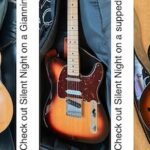Thanks to Lee at authorityguitar.com for this Ultimate Acoustic Guitar Wood Guide.

The Ultimate Acoustic Guitar Wood Guide: How Does Wood Affect Your Tone?
Are you ready to buy a stunning new acoustic guitar with an incredible sound? Are you confused about which type of acoustic guitar tonewood is best for your playing style and skills?
Check out our ‘Acoustic Guitar Wood Guide’ to learn about different wood species and how they affect sound quality. With this valuable know-how, choose your new guitar with ease and a touch of true expertise.
Experience Sound Quality and Playing Ease of Different Guitar Tonewoods
When you shop for a new acoustic guitar, take time to explore the different tonewoods. Discover how they affect the overall tone and sound quality as well as durability and playing ease. Whether you are buying your first guitar or you are replacing an older, worn model, you want a new instrument that is skillfully designed. You want a guitar within your own price range. Yet most of all, you are seeking a beautiful new instrument that fully satisfies your current playing abilities, desires, and needs.
Responsible guitar sellers encourage buyers to play different models before buying a new guitar. Some sellers have full knowledge of the tonewoods, their strengths, and their weaknesses. Yet for best results in choosing your ideal new guitar, you should have this information at your own fingertips.
Know Commonly Used Woods in Acoustic Guitar Production
Many varied wood species are used in the design and production of acoustic guitars. Yet the most commonly used types are mahogany, spruce, cedar, maple, and rosewood. Designers and manufacturers generally select woods according to their availability, cost, and overall quality. Hardwoods are usually chosen for the instrument’s framing, back, sides, neck, and fretboard. For acoustic guitar tops, somewhat stiff softwoods with good tonal qualities are the preferred choice.
Characteristics of these different guitar wood types and their use in making different parts of acoustic guitars include the following:
Best Guitar Woods for the Top (Soundboard)
The type of wood used for acoustic guitar soundboards has the most effect on the sound quality of the instrument. This is because the notes produced by the guitar strings travel via the bridge onto the soundboard. The sound’s vibrations are then amplified by the instrument’s top, as any good Acoustic Guitar Wood Guide will explain. For this reason, guitars with larger soundboards have louder sound when played.
• Cedar.
With less density than spruce and some other tonewoods, cedar offers good quality for producing acoustic guitar tops. It provides moderately rich overtones with pleasing warmth and medium levels of brightness.
• Koa.
This is a more expensive wood than cedar, and its sound quality improves with use. In the beginning, a guitar that has a soundboard made of koa has an extra-bright sound. Yet the more it is played over time, it mellows, converting into more enriched, warmer tonalities. At this point, it offers the richest sound in the middle-range notes.
• Mahogany.
As a dense wood type, mahogany has a less rapid sound to touch rate. It creates a substantial mid-range sound with strong volumetric quality and gentle overtones. This produces a smooth, earthy sound. Guitars with mahogany tops are ideal for playing blues numbers. They are also recommended for playing guitar with other instruments.
• Sitka Spruce.
Spruce is the most frequently used top wood for making acoustic guitars. Spruce is a lightweight yet strong durable wood. There are several different varieties, and the most common type is Sitka spruce. Sitka is a versatile soundboard wood, accommodating aggressive and subtle guitar playing equally well. With its wide-reaching dynamic range, this wood offers fine-caliber resonance for a wide array of tones. The light coloration of this wood looks beautiful when combined with darker tonewoods for guitar sides and backs.
• Adirondack Spruce.
This variety of spruce wood is ideal for producing soundboards. It provides a dramatic range of tonalities and enables loud, full guitar playing while maintaining good quality sound clarity. This type of spruce soundboard is a good choice for guitarists who favor aggressive playing.
• Engelmann and European Spruce.
Soundboards created from these spruce wood varieties are best suited for guitar players with a soft touch. If played aggressively, the sound quality diminishes.

Best Woods for Guitar Backs and Body Sides
If your guitar has a back and sides constructed of tone-sensitive wood, the sound generated via the instrument’s top is enhanced. Various types of tonewood offering different tone qualities when used for guitar backs and sides are as follows:
• Koa.
As well as making a top-rated soundboard wood, koa is also an ideal choice for constructing a guitar back and sides. Of course, it complements a guitar that has a koa top. Yet it is quite compatible with other tonewoods for guitar construction. This wood is in the more expensive range, and its sound improves with age and use.
• Mahogany.
With its versatile middle-range richness and character, this beautiful wood is an excellent choice for guitar backs and sides. Mahogany is a great selection if you like enhanced volume and density for mid-range tones. If you use this wood for a guitar’s top, back and sides, you can create a compressed, warm sound with volume and dominance. If you combine mahogany back and sides with a Sitka spruce guitar top, the sound produced will have a more mellow, warm tone.
Two Popular Varieties of Mahogany
There are actually two major types of mahogany in use today for acoustical guitar construction, Honduran and African:
Honduran Mahogany.
This type of mahogany is also known as genuine mahogany, tropical mahogany, American mahogany, and Brazilian mahogany. It is considered a high-quality tonewood. However, it is not as hard or durable as African mahogany or Sapele. Yet the Honduran variety is given a higher quality rating than African mahogany.
African Mahogany.
This type of mahogany (Khaya) is harder than Honduran mahogany, yet it is categorized as a lower-quality wood. When African mahogany is used for constructing guitar backs and sides, it can be difficult to determine a tone difference. Instruments made with backs and sides of either mahogany type can sound very much alike.
• Maple.
Due to its low rate of response, maple is a good wood for the guitar back and body sides, somewhat similar to mahogany. This reduces overtones, which results in less resonance and prolonged sound. This quality enhances the sound from the guitar top and reduces feedback if you are playing with a group. Maple actually gives focus and attention to individual tones.
For this reason, guitars with maple backs and sides are often favored by lead guitarists who seek note definition. Since maple is a light-colored wood, is frequently stained to create darker guitar backs and sides. Especially when combined with a spruce guitar top, maple backs and sides are usually given a darker contrasting stain.
• Rosewood.
This tonewood is quite popular for use in constructing acoustic guitar backs and sides. Rosewood differs significantly from maple. It offers a fine quality middle-range similar to mahogany. Yet it can also extend into the high tones and low tones to create deep, full bass notes and bright, bell-toned treble notes. This wood is also a good choice for quality finger-picking, strumming, and flat-picking.
With its enriched overtones and high rate of response, it enables a focused playing attack and plenty of resonance. However, this use of rosewood may contribute to some issues with feedback. A guitar with a rosewood back and sides in combination with a Sitka spruce top is often called the “Holy Grail” of tonewoods. Some guitarists proclaim this to be the ultimate guitar construction.
• Walnut.
Displaying some of the same qualities exhibited by koa, walnut is altered in tone quality over time. It has a deep, low register that will gain volume and character the more it is played. The top register is bright with more strength in the middle tones. Its mid-range features are considered in between those of rosewood and mahogany.
If a walnut guitar back and sides are combined with a cedar top for a relatively small guitar, the instrument can be ideal for enhanced finger styling. If, for a larger size guitar, you combine a walnut back and sides with a spruce top, it can have a more dynamic, aggressive response for flat-picking and strumming.
• Sapele.
This tonewood has similarities to mahogany. Both sapele and mahogany are used for top wood as well as back and side tonewood for guitars. They are also both in popular use for making guitar necks. Sapele is actually harder than Honduran and African mahogany, and sapele originated in West Africa.
The tone quality from a guitar made with sapele or mahogany can vary significantly. The sound will differ according to the other construction materials and what part of the guitar these woods are being used for. Guitars that contain sapele wood have a stronger treble register than those constructed with the use of mahogany.

Guitar Fretboard (Fingerboard)
The top-rated tonewoods for use in producing guitar fretboards or fingerboards are rosewood and ebony. The playing ease of your guitar and be affected by the guitar’s action, the neck size, the strings, and the body shape. However, the material used to create the fretboard (fingerboard) has the greatest influence of all. The surface of your guitar fretboard must be durable and smooth to promote ultimate quality “playability.”
Common Fretboard Woods
• Rosewood.
A rosewood fretboard can assist you in creating a warm, full tone. This wood’s pores are quite oily, and they lessen some overtones, allowing the enriching warm tones to dominate. These fingerboards need periodic cleaning. Especially if you want to bring more warmth to a guitar with a bright sound, rosewood is a good choice for the fretboard. Rosewood has a slick surface and needs no additional finishing. This wood is susceptible to drying, however, and it needs more ongoing maintenance than ebony. Rosewood is the most frequently used tonewood for fingerboards.
• Ebony.
This tonewood is also a dense hardwood used to make guitar fretboards. It enables guitarists to create a bright sound that may equal or even exceed the sound quality of maple fretboards. There is an ongoing discussion about which wood supports the ultimate quality sound.
One advantage of ebony is its lack of any requirement for surface finishing. Your ebony fretboard is lubricated naturally by the oil in your fingers as you play. Ebony wood only needs to be conditioned periodically since it maintains good oil and moisture levels.
If you like a dark fretboard and the smooth feel of ebony, it may be your best choice for your guitar fingerboard.
Best Guitar Neck Woods
The neck of your guitar should attract very little vibration and energy from the strings as you play. As much of this energy as possible should travel down the strings and into the soundboard via the bridge. For this reason, the guitar neck should be made of dense hardwood, since soft or slightly flexible wood can divert energy from the strings and soundboard.
Mahogany is the best choice for constructing acoustic guitar necks. As a sturdy hardwood with density, it is still relatively light and good for carving. American and African mahoganies are the two primary types used for producing guitar necks. Some acoustic guitars with nylon strings have cedar necks. Since nylon strings create lower tension when played than other string types, cedar necks are suitable for these guitars.
Enjoy the Path to Being a Skilled and Fulfilled Guitar Player
It is important for every beginning acoustic guitar player to experience the varied sound tones and playing ease of different tonewoods. The most commonly used woods in guitar production are mahogany, spruce, cedar, maple, and rosewood. All guitarists should become familiar with the qualities, strengths, and weaknesses of each wood species.
By examining, holding, and playing different brands, styles, and models of acoustic guitars, players become familiar with different woods. They distinguish different sound tones produced by different types of wooden guitar soundboards, backs, and body sides. As a new guitar player, you can soon determine even subtle differences in sound quality and “playability” of different designs.
Since many guitars are made using different wood combinations, you will learn the advantages of different constructions. From soundboard to back, sides, fretboard, and neck, you will acquire valuable knowledge and understanding of the guitar. You will discover your favorite tonewoods and how combining these woods can influence and enhance the appearance and sound of a guitar.
The more you learn about this beautiful, sensitive instrument as you learn to play, the faster you will advance. You will soon be a skilled and fulfilled intermediate guitarist on your path to becoming an expert. We hope that you have enjoyed this beginner’s Acoustic Guitar Wood Guide whilst gaining some helpful information and advice.
Now it is time to select your new guitar. Happy playing!
AuthorityGuitar has another detailed article to help you decide on Acoustic Vs Electric A Complete Beginners Guide. Go ahead and click away to see what we think.




